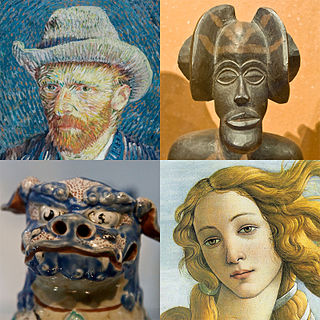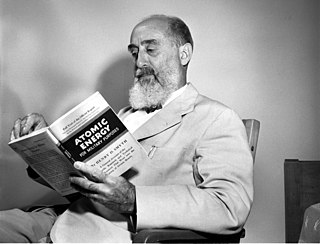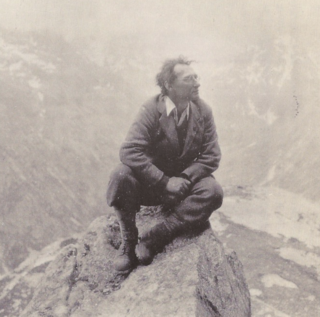
Art is a diverse range of human activities involving the creation of visual, auditory or performing artifacts (artworks), which express the creator's imagination, conceptual ideas, or technical skill, intended to be appreciated primarily for their beauty or emotional power. Other activities related to the production of works of art include art criticism and the history of art.

Aesthetics, or esthetics, is a branch of philosophy that deals with the nature of beauty and taste, as well as the philosophy of art. It examines subjective and sensori-emotional values, or sometimes called judgments of sentiment and taste.
Literary theory is the systematic study of the nature of literature and of the methods for literary analysis. Since the 19th century, literary scholarship includes literary theory and considerations of intellectual history, moral philosophy, social prophecy, and interdisciplinary themes relevant to how people interpret meaning. In the humanities in modern academia, the latter style of literary scholarship is a development of critical theory. Consequently, the word theory became an umbrella term for scholarly approaches to reading texts, some of which are informed by strands of sociology and Continental philosophy.
Literary criticism is the study, evaluation, and interpretation of literature. Modern literary criticism is often influenced by literary theory, which is the philosophical discussion of literature's goals and methods. Though the two activities are closely related, literary critics are not always, and have not always been, theorists.

In literary criticism, close reading is the careful, sustained interpretation of a brief passage of a text. A close reading emphasizes the single and the particular over the general, effected by close attention to individual words, the syntax, the order in which the sentences unfold ideas, as well as formal structures. A truly attentive close reading of a two-hundred-word poem might be thousands of words long without exhausting the possibilities for observation and insight.

Reader-response criticism is a school of literary theory that focuses on the reader and their experience of a literary work, in contrast to other schools and theories that focus attention primarily on the author or the content and form of the work.
Russian formalism was a school of literary criticism in Russia from the 1910s to the 1930s. It includes the work of a number of highly influential Russian and Soviet scholars such as Viktor Shklovsky, Yuri Tynianov, Vladimir Propp, Boris Eichenbaum, Roman Jakobson, Boris Tomashevsky, Grigory Gukovsky who revolutionised literary criticism between 1914 and the 1930s by establishing the specificity and autonomy of poetic language and literature. Russian formalism exerted a major influence on thinkers like Mikhail Bakhtin and Yuri Lotman, and on structuralism as a whole. The movement's members had a relevant influence on modern literary criticism, as it developed in the structuralist and post-structuralist periods. Under Stalin it became a pejorative term for elitist art.
New Criticism was a formalist movement in literary theory that dominated American literary criticism in the middle decades of the 20th century. It emphasized close reading, particularly of poetry, to discover how a work of literature functioned as a self-contained, self-referential aesthetic object. The movement derived its name from John Crowe Ransom's 1941 book The New Criticism.

Ivor Armstrong Richards, known as I. A. Richards, was an English educator, literary critic, and rhetorician. His work contributed to the foundations of the New Criticism, a formalist movement in literary theory which emphasized the close reading of a literary text, especially poetry, in an effort to discover how a work of literature functions as a self-contained and self-referential æsthetic object.
Monroe Curtis Beardsley was an American philosopher of art.
William Kurtz Wimsatt Jr. was an American professor of English, literary theorist, and critic. Wimsatt is often associated with the concept of the intentional fallacy, which he developed with Monroe Beardsley in order to discuss the importance of an author's intentions for the creation of a work of art.

Cleanth Brooks was an American literary critic and professor. He is best known for his contributions to New Criticism in the mid-20th century and for revolutionizing the teaching of poetry in American higher education. His best-known works, The Well Wrought Urn: Studies in the Structure of Poetry (1947) and Modern Poetry and the Tradition (1939), argue for the centrality of ambiguity and paradox as a way of understanding poetry. With his writing, Brooks helped to formulate formalist criticism, emphasizing "the interior life of a poem" and codifying the principles of close reading.
In literary theory and aesthetics, authorial intent refers to an author's intent as it is encoded in their work. Authorial intentionalism is the view, according to which an author's intentions should constrain the ways in which it is properly interpreted.
"The Death of the Author" is a 1967 essay by the French literary critic and theorist Roland Barthes (1915–1980). Barthes's essay argues against traditional literary criticism's practice of incorporating the intentions and biographical context of an author in an interpretation of a text, and instead argues that writing and creator are unrelated. The title is a pun on Le Morte d'Arthur, a 15th-century compilation of smaller Arthurian legend stories, written by Sir Thomas Malory.
In literary criticism, an objective correlative is a group of things or events which systematically represent emotions.
This is an alphabetical index of articles about aesthetics.
Nationality words link to articles with information on the nation's poetry or literature.
"The Frontiers of Criticism" is a lecture given by T. S. Eliot at the University of Minnesota in 1956. It was reprinted in On Poetry and Poets, a collection of Eliot's critical essays, in 1957. The essay is an attempt by Eliot to define the boundaries of literary criticism: to say what does, and what does not, constitute truly literary criticism, as opposed to, for example, a study in history based upon a work of literature. The essay is significant because it represents Eliot's response to the New Critical perspective which had taken the academic study of literature by storm during Eliot's lifetime. It also presents an analysis of some of its author's own poetic works, an unusual characteristic for modern criticism—it has become far more usual today for poets and critics to be in separate camps, rather than united in one individual. Perhaps even more importantly, it demonstrates the progress and change in Eliot's own critical thought over the years between 1919 and 1956.
In literature, the paradox is an anomalous juxtaposition of incongruous ideas for the sake of striking exposition or unexpected insight. It functions as a method of literary composition and analysis that involves examining apparently contradictory statements and drawing conclusions either to reconcile them or to explain their presence.





